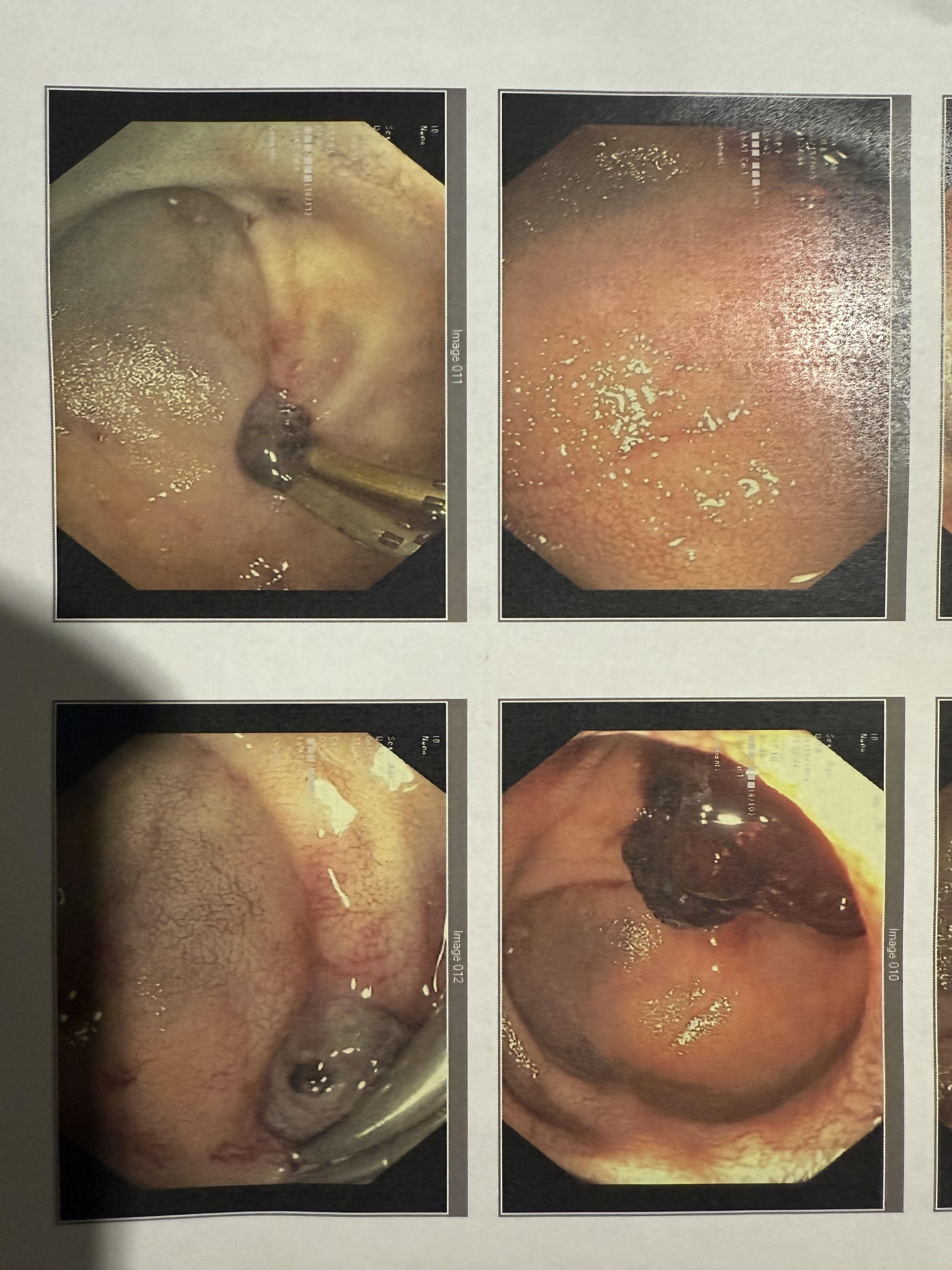Sunday Poster Session
Category: GI Bleeding
P0965 - Successful Endoscopic Treatment of Jejunal Diverticular Hemorrhage in an Elderly Patient
Sunday, October 26, 2025
3:30 PM - 7:00 PM PDT
Location: Exhibit Hall

Jyoti Yadav, MD (she/her/hers)
The Wright Center for Graduate Medical Education
Scranton, PA
Presenting Author(s)
Jyoti Yadav, MD1, Preetika Sharma, MD1, Sunny Kumar, MD2, Himani Mongia, MBBS1, Hany Eskarous, MD1, Aman Ali, MD3
1The Wright Center for Graduate Medical Education, Scranton, PA; 2Wright Center for Graduate Medical Education, Scranton, PA; 3Wilkes-Barre General Hospital, Scranton, PA
Introduction: Jejunal diverticula are uncommon, with a prevalence ranging from 0.3% to 4.6%. They occur less frequently than colonic or duodenal diverticula and are an unusual cause of gastrointestinal bleeding. Depending on severity and location, diverticular hemorrhage can present as weakness, low blood pressure, tachycardia, low hemoglobin, anemia, hematochezia, or melena. To diagnose diverticular hemorrhage, colonoscopy, radionuclide scanning, or angiography can be used . Diverticular hemorrhage can sometimes resolve without intervention. However, management is critical, especially in those patient populations who need to be on anticoagulation and antiplatelets due to increased risk of impaired clotting of diverticular bleeds.
Case Description/
Methods: AnvAn 82-year-old female with a history of coronary artery disease and paroxysmal atrial fibrillation, who was on clopidogrel and apixaban, presented with symptoms of fatigue, lightheadedness, and melena. Her hemoglobin level had decreased from 12 g/dl to 6.6 g/dl upon presentation. Although a Computed Tomography Angiogram was inconclusive, a nuclear scan detected active bleeding in the jejunum. During a push enteroscopy combined with esophagogastroduodenoscopy, multiple jejunal diverticula were found, including one with an actively bleeding vessel at 60 cm from the scope's entry point. The area was irrigated, and two hemostatic clips were applied, with a carbon tattoo placed nearby for future reference. Following the procedure, the patient's hemoglobin levels stabilized, and she was able to resume clopidogrel and apixaban. She was discharged in stable condition 48 hours later.
Discussion: Jejunal diverticula are rare but should be considered as one of the differential for gastrointestinal bleeding. This case highlights the diagnostic and therapeutic challenges of managing jejunal diverticular hemorrhage in patients on anticoagulation/antiplatelet therapy, which increases bleeding risk due to impaired clotting mechanisms. Given surgical risks in elderly patients with comorbidities, endoscopic hemostasis was pursued successfully although surgical resection has been traditionally practiced in such cases.

Figure: Endoscopic Visualization of Jejunal Diverticular Bleeding: Diagnostic and Therapeutic Interventions
Disclosures:
Jyoti Yadav indicated no relevant financial relationships.
Preetika Sharma indicated no relevant financial relationships.
Sunny Kumar indicated no relevant financial relationships.
Himani Mongia indicated no relevant financial relationships.
Hany Eskarous indicated no relevant financial relationships.
Aman Ali indicated no relevant financial relationships.
Jyoti Yadav, MD1, Preetika Sharma, MD1, Sunny Kumar, MD2, Himani Mongia, MBBS1, Hany Eskarous, MD1, Aman Ali, MD3. P0965 - Successful Endoscopic Treatment of Jejunal Diverticular Hemorrhage in an Elderly Patient, ACG 2025 Annual Scientific Meeting Abstracts. Phoenix, AZ: American College of Gastroenterology.
1The Wright Center for Graduate Medical Education, Scranton, PA; 2Wright Center for Graduate Medical Education, Scranton, PA; 3Wilkes-Barre General Hospital, Scranton, PA
Introduction: Jejunal diverticula are uncommon, with a prevalence ranging from 0.3% to 4.6%. They occur less frequently than colonic or duodenal diverticula and are an unusual cause of gastrointestinal bleeding. Depending on severity and location, diverticular hemorrhage can present as weakness, low blood pressure, tachycardia, low hemoglobin, anemia, hematochezia, or melena. To diagnose diverticular hemorrhage, colonoscopy, radionuclide scanning, or angiography can be used . Diverticular hemorrhage can sometimes resolve without intervention. However, management is critical, especially in those patient populations who need to be on anticoagulation and antiplatelets due to increased risk of impaired clotting of diverticular bleeds.
Case Description/
Methods: AnvAn 82-year-old female with a history of coronary artery disease and paroxysmal atrial fibrillation, who was on clopidogrel and apixaban, presented with symptoms of fatigue, lightheadedness, and melena. Her hemoglobin level had decreased from 12 g/dl to 6.6 g/dl upon presentation. Although a Computed Tomography Angiogram was inconclusive, a nuclear scan detected active bleeding in the jejunum. During a push enteroscopy combined with esophagogastroduodenoscopy, multiple jejunal diverticula were found, including one with an actively bleeding vessel at 60 cm from the scope's entry point. The area was irrigated, and two hemostatic clips were applied, with a carbon tattoo placed nearby for future reference. Following the procedure, the patient's hemoglobin levels stabilized, and she was able to resume clopidogrel and apixaban. She was discharged in stable condition 48 hours later.
Discussion: Jejunal diverticula are rare but should be considered as one of the differential for gastrointestinal bleeding. This case highlights the diagnostic and therapeutic challenges of managing jejunal diverticular hemorrhage in patients on anticoagulation/antiplatelet therapy, which increases bleeding risk due to impaired clotting mechanisms. Given surgical risks in elderly patients with comorbidities, endoscopic hemostasis was pursued successfully although surgical resection has been traditionally practiced in such cases.

Figure: Endoscopic Visualization of Jejunal Diverticular Bleeding: Diagnostic and Therapeutic Interventions
Disclosures:
Jyoti Yadav indicated no relevant financial relationships.
Preetika Sharma indicated no relevant financial relationships.
Sunny Kumar indicated no relevant financial relationships.
Himani Mongia indicated no relevant financial relationships.
Hany Eskarous indicated no relevant financial relationships.
Aman Ali indicated no relevant financial relationships.
Jyoti Yadav, MD1, Preetika Sharma, MD1, Sunny Kumar, MD2, Himani Mongia, MBBS1, Hany Eskarous, MD1, Aman Ali, MD3. P0965 - Successful Endoscopic Treatment of Jejunal Diverticular Hemorrhage in an Elderly Patient, ACG 2025 Annual Scientific Meeting Abstracts. Phoenix, AZ: American College of Gastroenterology.
